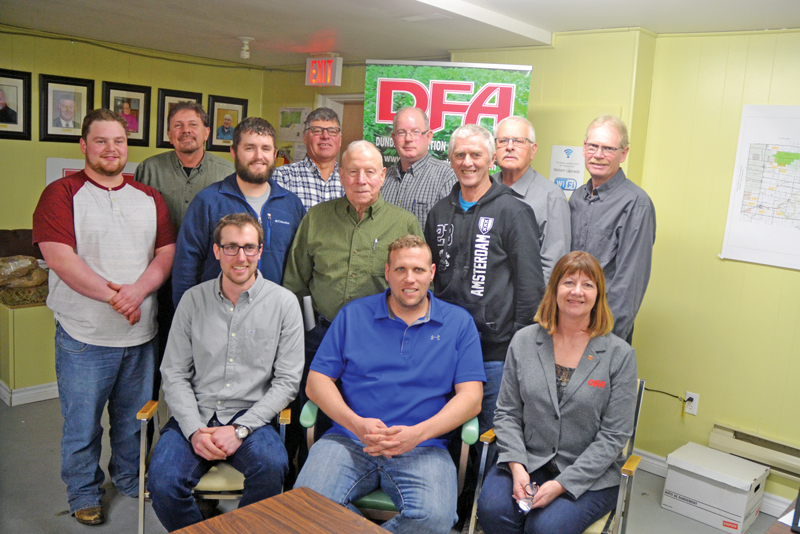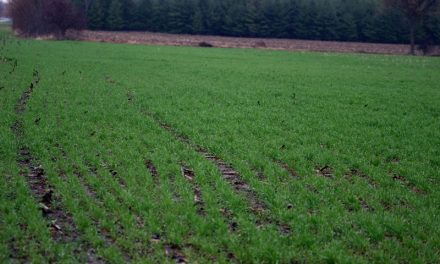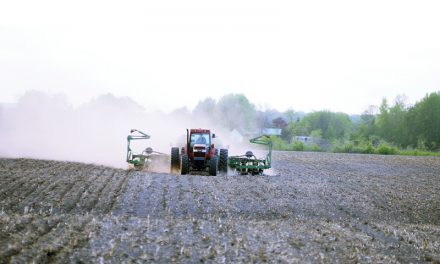Ready to learn
Steven Byvelds welcomed a large crowd and introduced an expert lineup of speakers during the Dundas Drainage Day held at the Chesterville Legion Hall on Fri., March 23. Sawyer Helmer photo
by Kalynn Sawyer Helmer
AgriNews Staff Writer
CHESTERVILLE – Last year, Steven Byvelds, past president and current director of the Dundas Federation of Agriculture (DFA), proposed to organize an event for producers and landowners about rural drainage. On Fri., March 23, he did just that. The full-day speaker series featured six experts who spoke to a packed crowd at the Chesterville Legion about all things drainage.
“From my previous municipal life and experiences, I learned that there is a lot of information that landowners and farmers need to have. Education is a good thing. After the 2017 season, I think a lot of us were thankful we had most of the municipal drains up to speck,” said Byvelds while kicking off the day.
DFA, with Byvelds as the lead on this project, partnered with Ontario Federation of Agriculture (OFA), South Nation Conservation (SNC) and the Dundas Soil and Crop Improvement Association (DSCIA).
The agenda began with insights from Sid Vander Veen, OMAFRA Drainage Supervisor Coordinator. Tile drainage on agricultural land offers a number of benefits. Some which Vander Veen laid out were earlier planting dates, reduced soil erosion, improved drought resistance and increased crop productivity. What the audience members may not have known is that the practice dates back to the 1800s.
Improperly installed tile drainage is actually worse than none at all, but that did not stop people from advertising their services as tile installers. Vander Veen explained that because of an influx of poorly installed tiles from amateurs, the Agricultural Tile Drainage Installation Act came into effect in the 1970s. This act, which only applies to agricultural land, requires contractors to acquire three different licenses and a lot of training in order to achieve the official title.
Vander Veen continued by moving on to other types of drainage. He gave advice about drainage disputes between neighbours and referred to a number of cases in which drainage, caused neighbours to involve the courts.
These cases Vander Veen said usually fall under the Common Law. He broke drainage issues down to two categories: natural watercourses and surface water. Riparian landowners have a right to drainage when it comes to natural watercourses. Alternatively, there is no right of drainage for surface water. However, Vander Veen cautioned that when protecting one’s property from surface water, by building berms or dykes, the water must drain to an area that will not do damage to other properties, otherwise there could be grounds for a lawsuit.
“Handshake agreements are great until you are no longer friendly with your neighbours,” said Vander Veen. To avoid this issue, he recommended a written agreement registered on the land to ensure a binding agreement even if the property changes owner.
Vander Veen was followed by Lorne Franklin of Robinson Consultants who had some advice on municipal drain maintenance. After a hot lunch from Lyle Skuce, Jackie Kelly-Pemberton OFA Director of District 11 gave a brief rundown of OFA and DFA programs and initiatives. She encouraged producers to get involved and join the federations.
The majority of the latter part of the afternoon was filled with information from SNC. Geoff Owens covered Conservation Authority Act regulations and Michelle Cavanagh touched on some of the proposed changes to the Fisheries Act and how they could affect landowners. Lastly from SNC, Ronda Boutz explained the benefits of controlled tile drainage for managing land in dry growing seasons.
Owens kicked things off by acknowledging the conservation authorities for their efforts to make regulations more consistent across Ontario municipalities. He continued that the Conservation Authorities Act (CA Act) and the Drainage Act are both aiming for the same outcome through different channels and regulations. Owens offered advice for dealing with drainage issues and encouraged those with questions to contact him through SNC. “We recognize that we have a lot of power under the CA Act but we don’t go out and accuse people. We want to educate, discuss and help find a solution,” said Owens.
Following Owens, Cavanagh braved the crowd to explain the proposed changes to the Fisheries Act. Six of the most applicable changes for landowners according to Cavanagh include; change from “protection for commercial, recreational or Aboriginal fisheries” to “protection for all fish and fish habitat;” from “Protection against serious harm to fish” to prohibition against ‘harmful alteration, disruption or destruction of fish habitat’;” from “no requirement to publicly release decision on projects” to “creation of a public, online registry for project decisions;” from “no reference o consideration of the right of Indigenous people and their knowledge to inform decision making” to “strengthen the role of Indigenous peoples in project reviews, monitoring and policy development;” from no definition on which projects would always require authorization” to “regulations that define which projects would always require authorization;” and from “self-assessment process” to “codes of practice for small, routine projects.”
When the act was changed in 2012, Cavanagh explained that SNC was no longer able to make final judgements for local projects. However since the change, Ontario’s Department of Fisheries and Oceans has still used SNC’s judgement on local issues. Cavanagh said it is her hope that the regulations will once again allow local issues to be dealt with by SNC to make it easier on landowners. “It’s more efficient and more effective to have the one window approach,” she said.
Ronda Boutz, the final speaker from SNC, outlined the benefits of controlled tile drainage. The controlled tiles can be turned off when not necessary and will overflow to allow water to leave the field when there is an influx. The systems shown by Boutz work best on a one per cent slope or less and require roughly one system per 10 acres. The systems help to preserve water if there is a shortage during the growing season. She added that there are a number of grants available, some through SNC, to help offset the costs of the systems.
Last to the podium was Albert Zandbergen, of Quintan Products who rounded off the informative day with a contractor’s point of view and the challenges contractors face with earlier planting dates and later snowfalls.
Byvelds seemed happy with the turnout and said another such day would not be necessary for roughly five years, or if some of the Act regulations were to change. Otherwise the comments from those in attendance were positive and confirmed there was a lot to learn at the drainage day.













